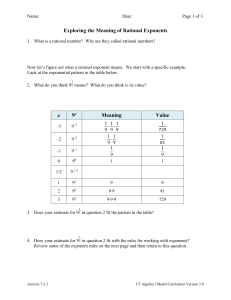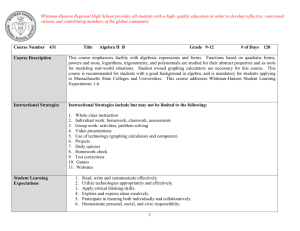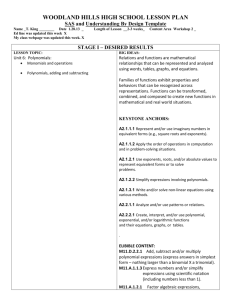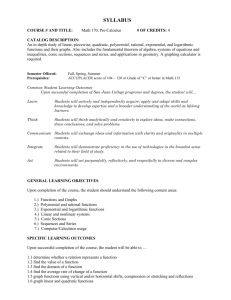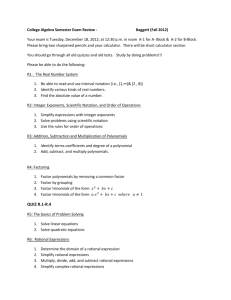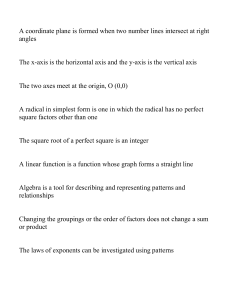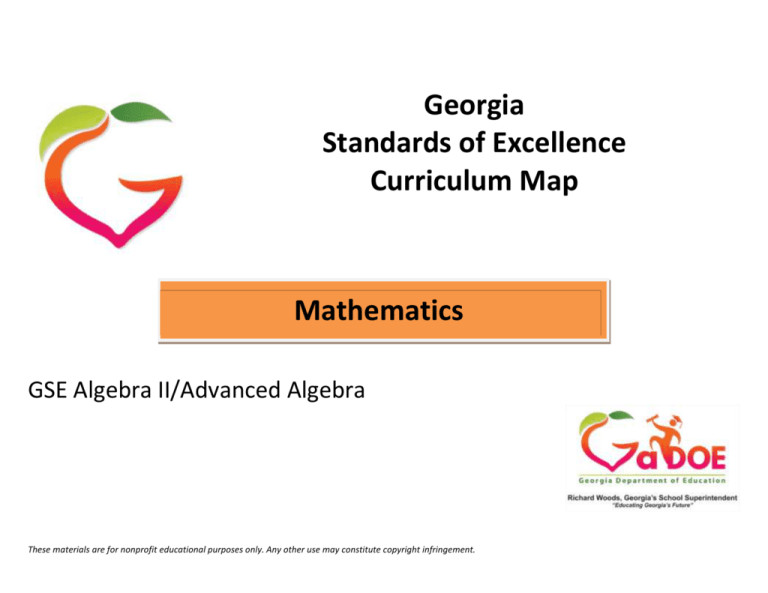
Georgia
Standards of Excellence
Curriculum Map
Mathematics
GSE Algebra II/Advanced Algebra
These materials are for nonprofit educational purposes only. Any other use may constitute copyright infringement.
Georgia Department of Education
GSE Algebra II/Advanced Algebra Curriculum Map
1st Semester
2nd Semester
Unit 1
(3 – 4 weeks)
Unit 2
(3 – 4 weeks)
Unit 3
(4 – 5 weeks)
Unit 4
(5 – 6 weeks)
Unit 5
(4 – 5 weeks)
Unit 6
(4 – 5 weeks)
Unit 7
(3 – 4 weeks)
Quadratics
Revisited
Operations With
Polynomials
Polynomial
Functions
Rational & Radical
Relationships
Exponential &
Logarithms
Mathematical
Modeling
Inferences and
Conclusions from
Data
MGSE9-12.N.CN.1
MGSE9-12.N.CN.2
MGSE9-12.N.CN.3
MGSE9-12.N.CN.7
MGSE9-12.N.CN.8
MGSE9-12.A.REI.4
MGSE9-12.A.REI.4b
MGSE9-12.N.RN.1
MGSE9-12.N.RN.2
MGSE9-12.A.APR.1
MGSE9-12.A.APR.5
MGSE9-12.A.APR.6
MGSE9-12.F.BF.1
MGSE9-12.F.BF.1b
MGSE9-12.F.BF.1c
MGSE9-12.F.BF.4
MGSE9-12.F.BF.4a
MGSE9-12.F.BF.4b
MGSE9-12.F.BF.4c
MGSE9-12.N.CN.9
MGSE9-12.A.SSE.1
MGSE9-12.A.SSE.1a
MGSE9-12.A.SSE.1b
MGSE9-12.A.SSE.2
MGSE9-12.A.APR.2
MGSE9-12.A.APR.3
MGSE9-12.A.APR.4
MGSE9-12.F.IF.4
MGSE9-12.F.IF.7
MGSE9-12.F.IF.7c
MGSE9-12.A.APR.7
MGSE9-12.A.CED.1
MGSE9-12.A.CED.2
MGSE9-12.A.REI.2
MGSE9-12.F.IF.4
MGSE9-12.F.IF.5
MGSE9-12.F.IF.7
MGSE9-12.F.IF.7b
MGSE9-12.F.IF.7d
MGSE9-12.A.SSE.3
MGSE9-12.A.SSE.3c
MGSE9-12.F.IF.7
MGSE9-12.F.IF.7e
MGSE9-12.F.IF.8
MGSE9-12.F.IF.8b
MGSE9-12.F.BF.5
MGSE9-12.F.LE.4
MGSE9-12.A.SSE.4
MGSE9-12.A.CED.1
MGSE9-12.A.CED.2
MGSE9-12.A.CED.3
MGSE9-12.A.CED.4
MGSE9-12.A.REI.11
MGSE9-12.F.IF.6
MGSE9-12.F.IF.9
MGSE9-12.F.BF.3
MGSE9-12.S.ID.2
MGSE9-12.S.ID.4
MGSE9-12.S.IC.1
MGSE9-12.S.IC.2
MGSE9-12.S.IC.3
MGSE9-12.S.IC.4
MGSE9-12.S.IC.5
MGSE9-12.S.IC.6
These units were written to build upon concepts from prior units, so later units contain tasks that depend upon the concepts addressed in earlier units.
All units will include the Mathematical Practices and indicate skills to maintain.
*Revised standards indicated in bold red font.
NOTE: Mathematical standards are interwoven and should be addressed throughout the year in as many different units and tasks as possible in order to stress the natural connections that exist among mathematical topics.
Grade 9-12 Key:
Number and Quantity Strand: RN = The Real Number System, Q = Quantities, CN = Complex Number System, VM = Vector and Matrix Quantities
Algebra Strand: SSE = Seeing Structure in Expressions, APR = Arithmetic with Polynomial and Rational Expressions, CED = Creating Equations, REI = Reasoning with Equations and Inequalities
Functions Strand: IF = Interpreting Functions, LE = Linear and Exponential Models, BF = Building Functions, TF = Trigonometric Functions
Geometry Strand: CO = Congruence, SRT = Similarity, Right Triangles, and Trigonometry, C = Circles, GPE = Expressing Geometric Properties with Equations, GMD = Geometric Measurement and Dimension,
MG = Modeling with Geometry
Statistics and Probability Strand: ID = Interpreting Categorical and Quantitative Data, IC = Making Inferences and Justifying Conclusions, CP = Conditional Probability and the Rules of Probability, MD = Using Probability
to Make Decisions
Richard Woods, State School Superintendent
July 2015 ● Page 2 of 7
All Rights Reserved
Georgia Department of Education
Georgia Standards of Excellence Algebra II/Advanced Algebra
Curriculum Map Rationale
Unit1: Students will revisit solving quadratic equations in this unit. Students explore relationships between number systems: whole numbers, integers, rational
numbers, real numbers, and complex numbers. Students will perform operations with complex numbers and solve quadratic equations with complex solutions.
Students will also extend the laws of exponents to rational exponents and use those properties to evaluate and simplify expressions containing rational exponents.
Unit 2: This unit develops the structural similarities between the system of polynomials and the system of integers. Students draw on analogies between polynomial
arithmetic and base-ten computation, focusing on properties of operations, particularly the distributive property. Students connect multiplication of polynomials with
multiplication of multi-digit integers, and division of polynomials with long division of integers. Students will find inverse functions and verify by composition that
one function is the inverse of another function.
Unit 3: In this unit, students continue their study of polynomials by identifying zeros and making connections between zeros of a polynomial and solutions of a
polynomial equation. Students will see how the Fundamental Theorem of Algebra can be used to determine the number of solutions of a polynomial equation and will
find all the roots of those equations. Students will graph polynomial functions and interpret the key characteristics of the function.
Unit 4: Rational numbers extend the arithmetic of integers by allowing division by all numbers except 0. Similarly, rational expressions extend the arithmetic of
polynomials by allowing division by all polynomials except the zero polynomial. A central theme of this unit is that the arithmetic of rational expressions is governed
by the same rules as the arithmetic of rational numbers. Similarly, radical expressions follow the rules governed by irrational numbers.
Unit 5: Students extend their work with exponential functions to include solving exponential equations with logarithms. They analyze the relationship between these
two functions.
Unit 6: In this unit students synthesize and generalize what they have learned about a variety of function families. They explore the effects of transformations on
graphs of diverse functions, including functions arising in an application, in order to abstract the general principle that transformations on a graph always have the
same effect regardless of the type of the underlying functions. They identify appropriate types of functions to model a situation, they adjust parameters to improve the
model, and they compare models by analyzing appropriateness of fit and making judgments about the domain over which a model is a good fit. They determine
whether it is best to model with multiple functions creating a piecewise function. Students will also explore the sum of finite geometric series.
Unit 7: In this unit, students see how the visual displays and summary statistics they learned in earlier grades relate to different types of data and to probability
distributions. They identify different ways of collecting data— including sample surveys, experiments, and simulations—and the role that randomness and careful
design play in the conclusions that can be drawn.
The pacing suggested on the curriculum map will allow students to gain a foundation in quadratics, polynomials, rational functions, radical functions, exponential
functions, and logarithms before they begin the Mathematical Modeling unit. The Mathematical Modeling unit will bring these functions together and will introduce
the sum of finite geometric series and piecewise functions. Students will have an opportunity to revisit many of these functions while working the tasks in unit 6. The
course closes with the final unit discussing data and probability distributions.
Richard Woods, State School Superintendent
July 2015 ● Page 3 of 7
All Rights Reserved
Georgia Department of Education
GSE Algebra II/Advanced Algebra Expanded Curriculum Map – 1st Semester
Standards for Mathematical Practice
5 Use appropriate tools strategically.
6 Attend to precision.
7 Look for and make use of structure.
8 Look for and express regularity in repeated reasoning.
1st Semester
1 Make sense of problems and persevere in solving them.
2 Reason abstractly and quantitatively.
3 Construct viable arguments and critique the reasoning of others.
4 Model with mathematics.
Unit 1
Unit 2
Unit 3
Unit 4
Quadratics Revisited
Operations With Polynomials
Polynomial Functions
Rational & Radical Relationships
Perform arithmetic operations with
complex numbers.
MGSE9-12.N.CN.1 Understand there is a
complex number i such that i2 = −1, and
every complex number has the form a + bi
where a and b are real numbers.
MGSE9-12.N.CN.2 Use the relation i2 = –1
and the commutative, associative, and
distributive properties to add, subtract, and
multiply complex numbers.
MGSE9-12.N.CN.3 Find the conjugate of a
complex number; use the conjugate to find
the absolute value (modulus) and quotient
of complex numbers.
Use complex numbers in polynomial
identities and equations.
MGSE9-12.N.CN.7 Solve quadratic
equations with real coefficients that have
complex solutions by (but not limited to)
square roots, completing the square, and
the quadratic formula.
MGSE9-12.N.CN.8 Extend polynomial
identities to include factoring with complex
numbers. For example, rewrite x2 + 4 as (x +
2i)(x – 2i).
Solve equations and inequalities in one
variable
MGSE9-12.A.REI.4 Solve quadratic
equations in one variable.
MGSE9-12.A.REI.4b Solve quadratic
equations by inspection (e.g., for x 2 = 49),
taking square roots, factoring, completing
the square, and the quadratic formula, as
appropriate to the initial form of the
equation (limit to real number solutions).
Perform arithmetic operations on
polynomials
MGSE9-12.A.APR.1 Add, subtract, and
multiply polynomials; understand that
polynomials form a system analogous to the
integers in that they are closed under these
operations.
MGSE9-12.A.APR.5 Know and apply that
the Binomial Theorem gives the expansion
of (x + y)n in powers of x and y for a
positive integer n, where x and y are any
numbers, with coefficients determined for
example by Pascal’s Triangle.
Rewrite rational expressions
MGSE9-12.A.APR.6 Rewrite simple
rational expressions in different forms
using inspection, long division, or a
computer algebra system; write a(x)/b(x) in
the form q(x) + r(x)/b(x), where a(x), b(x),
q(x), and r(x) are polynomials with the
degree of r(x) less than the degree of b(x).
Build a function that models a relationship
between two quantities
MGSE9-12.F.BF.1 Write a function that
describes a relationship between two
quantities.
MGSE9-12.F.BF.1b Combine standard
function types using arithmetic operations
in contextual situations (Adding,
subtracting, and multiplying functions of
different types).
MGSE9-12.F.BF.1c Compose functions. For
example, if T(y) is the temperature in the
atmosphere as a function of height, and h(t) is
the height of a weather balloon as a function
of time, then T(h(t)) is the temperature at the
location of the weather balloon as a function
MGSE9-12.N.CN.9 Use the Fundamental
Theorem of Algebra to find all roots of a
polynomial equation
Interpret the structure of expressions
MGSE9-12.A.SSE.1 Interpret expressions
that represent a quantity in terms of its
context.
MGSE9-12.A.SSE.1a Interpret parts of an
expression, such as terms, factors, and
coefficients, in context.
MGSE9-12.A.SSE.1b Given situations
which utilize formulas or expressions with
multiple terms and/or factors, interpret the
meaning (in context) of individual terms or
factors.
MGSE9-12.A.SSE.2 Use the structure of an
expression to rewrite it in different
equivalent forms. For example, see x 4 – y4
as (x2)2 - (y2)2, thus recognizing it as a
difference of squares that can be factored
as (x2 – y2) (x2 + y2).
Understand the relationship between zeros
and factors of polynomials
MGSE9-12.A.APR.2 Know and apply the
Remainder Theorem: For a polynomial p(x)
and a number a, the remainder on division by
x – a is p(a), so p(a) = 0 if and only if (x – a) is
a factor of p(x).
MGSE9-12.A.APR.3 Identify zeros of
polynomials when suitable factorizations are
available, and use the zeros to construct a
rough graph of the function defined by the
polynomial.
Use polynomial identities to solve problems
MGSE9-12.A.APR.4 Prove polynomial
identities and use them to describe numerical
relationships. For example, the polynomial
Rewrite rational expressions
MGSE9-12.A.APR.7 Understand that rational
expressions form a system analogous to the
rational numbers, closed under addition,
subtraction, multiplication, and division by a
nonzero rational expression; add, subtract,
multiply, and divide rational expressions.
Create equations that describe numbers or
relationships
MGSE9-12.A.CED.1 Create equations and
inequalities in one variable and use them to
solve problems. Include equations arising
from linear, quadratic, simple rational, and
exponential functions (integer inputs only).
MGSE9-12.A.CED.2 Create linear,
quadratic, and exponential equations in two
or more variables to represent relationships
between quantities; graph equations on
coordinate axes with labels and scales.
(Limit to rational and radical functions. The
phrase “in two or more variables” refers to
formulas like the compound interest formula,
in which A = P(1 + r/n)nt has multiple
variables.)
Understand solving equations as a process
of reasoning and explain the reasoning
MGSE9-12.A.REI.2 Solve simple rational
and radical equations in one variable, and give
examples showing how extraneous solutions
may arise.
MGSE9-12.F.IF.4 Using tables, graphs, and
verbal descriptions, interpret the key
characteristics of a function which models
the relationship between two quantities.
Sketch a graph showing key features
including: intercepts; interval where the
function is increasing, decreasing, positive,
Extend the properties of exponents to
Richard Woods, State School Superintendent
July 2015 ● Page 4 of 7
All Rights Reserved
Georgia Department of Education
rational exponents.
MGSE9-12.N.RN.1 Explain how the
meaning of rational exponents follows from
extending the properties of integer
exponents to rational numbers, allowing for
a notation for radicals in terms of rational
exponents. For example, we define 5(1/3) to be
the cube root of 5 because we want [5(1/3)]3 =
5[(1/3) x 3] to hold, so [5(1/3)]3 must equal 5.
MGSE9-12.N.RN.2 Rewrite expressions
involving radicals and rational exponents
using the properties of exponents.
of time.
Build new functions from existing functions
MGSE9-12.F.BF.4 Find inverse functions.
MGSE9-12.F.BF.4a Solve an equation of the
form f(x) = c for a simple function f that has
an inverse and write an expression for the
inverse. For example, f(x) =2(x3) or f(x) =
(x+1)/(x-1) for x ≠ 1.
MGSE9-12.F.BF.4b Verify by composition
that one function is the inverse of another.
MGSE9-12.F.BF.4c Read values of an
inverse function from a graph or a table, given
that the function has an inverse.
identity (x2 + y2)2 = (x2 – y2)2 + (2xy)2 can be
used to generate Pythagorean triples.
Interpret functions that arise in
applications in terms of the context
MGSE9-12.F.IF.4 Using tables, graphs, and
verbal descriptions, interpret the key
characteristics of a function which models
the relationship between two quantities.
Sketch a graph showing key features
including: intercepts; interval where the
function is increasing, decreasing, positive,
or negative; relative maximums and
minimums; symmetries; end behavior; and
periodicity.
Analyze functions using different
representations
MGSE9-12.F.IF.7 Graph functions
expressed algebraically and show key
features of the graph both by hand and by
using technology.
MGSE9-12.F.IF.7c Graph polynomial
functions, identifying zeros when suitable
factorizations are available, and showing end
behavior.
Richard Woods, State School Superintendent
July 2015 ● Page 5 of 7
All Rights Reserved
or negative; relative maximums and
minimums; symmetries; end behavior; and
periodicity.
Interpret functions that arise in
applications in terms of the context
MGSE9-12.F.IF.5 Relate the domain of a
function to its graph and, where applicable, to
the quantitative relationship it describes. For
example, if the function h(n) gives the number
of person-hours it takes to assemble n engines
in a factory, then the positive integers would
be an appropriate domain for the function.
Analyze functions using different
representations
MGSE9-12.F.IF.7 Graph functions
expressed algebraically and show key
features of the graph both by hand and by
using technology.
MGSE9-12.F.IF.7b Graph square root, cube
root, and piecewise-defined functions,
including step functions and absolute value
functions.
MGSE9-12.F.IF.7d Graph rational functions,
identifying zeros and asymptotes when
suitable factorizations are available, and
showing end behavior.
Georgia Department of Education
GSE Algebra II/Advanced Algebra Expanded Curriculum Map – 2nd Semester
1 Make sense of problems and persevere in solving them.
2 Reason abstractly and quantitatively.
3 Construct viable arguments and critique the reasoning of others.
4 Model with mathematics.
Unit 5
Standards for Mathematical Practice
5 Use appropriate tools strategically.
6 Attend to precision.
7 Look for and make use of structure.
8 Look for and express regularity in repeated reasoning.
2nd Semester
Unit 6
Unit 7
Exponential & Logarithms
Mathematical Modeling
Inferences & Conclusions from Data
Write expressions in equivalent forms to solve problems
MGSE9-12.A.SSE.3 Choose and produce an equivalent form
of an expression to reveal and explain properties of the
quantity represented by the expression.
MGSE9-12.A.SSE.3c Use the properties of exponents to
transform expressions for exponential functions. For
example, the expression 1.15t , where t is in years, can be
rewritten as [1.15(1/12)](12t) ≈ 1.012(12t) to reveal the
approximate equivalent monthly interest rate if the annual
rate is 15%.
Analyze functions using different representations
MGSE9-12.F.IF.7 Graph functions expressed algebraically
and show key features of the graph both by hand and by
using technology.
MGSE9-12.F.IF.7e Graph exponential and logarithmic
functions, showing intercepts and end behavior, and
trigonometric functions, showing period, midline, and
amplitude.
MGSE9-12.F.IF.8 Write a function defined by an expression
in different but equivalent forms to reveal and explain different
properties of the function.
MGSE9-12.F.IF.8b Use the properties of exponents to
interpret expressions for exponential functions. For example,
identify percent rate of change in functions such as y = (1.02) t,
y = (0.97)t, y = (1.01)(12t), y = (1.2)(t/10), and classify them as
representing exponential growth and decay.
Build new functions from existing functions
MGSE9-12.F.BF.5 Understand the inverse relationship
between exponents and logarithms and use this relationship to
solve problems involving logarithms and exponents.
Construct and compare linear, quadratic, and exponential
models and solve problems
MGSE9-12.F.LE.4 For exponential models, express as a
logarithm the solution to ab(ct) = d where a, c, and d are
numbers and the base b is 2, 10, or e; evaluate the logarithm
using technology.
Write expressions in equivalent forms to solve problems
MGSE9-12.A.SSE.4 Derive the formula for the sum of a finite
geometric series (when the common ratio is not 1), and use the
formula to solve problems. For example, calculate mortgage
payments.
MGSE9-12.A.CED.1 Create equations and inequalities in
one variable and use them to solve problems. Include
equations arising from linear, quadratic, simple rational,
and exponential functions (integer inputs only).
MGSE9-12.A.CED.2 Create linear, quadratic, and
exponential equations in two or more variables to represent
relationships between quantities; graph equations on
coordinate axes with labels and scales. (The phrase “in two
or more variables” refers to formulas like the compound
interest formula, in which A = P(1 + r/n)nt has multiple
variables.)
MGSE9-12.A.CED.3 Represent constraints by equations or
inequalities, and by systems of equation and/or inequalities,
and interpret data points as possible (i.e. a solution) or not
possible (i.e. a non-solution) under the established
constraints.
MGSE9-12.A.CED.4 Rearrange formulas to highlight a
quantity of interest using the same reasoning as in solving
equations. Examples: Rearrange Ohm’s law V = IR to
highlight resistance R; Rearrange area of a circle formula
A = π r2 to highlight the radius r.
Represent and solve equations and inequalities graphically
MGSE9-12.A.REI.11 Using graphs, tables, or successive
approximations, show that the solution to the equation
f(x) = g(x) is the x-value where the y-values of f(x) and g(x)
are the same.
Interpret functions that arise in applications in terms of the
context
MGSE9-12.F.IF.6 Calculate and interpret the average rate of
change of a function (presented symbolically or as a table) over
a specified interval. Estimate the rate of change from a graph.
MGSE9-12.F.IF.9 Compare properties of two functions
Summarize, represent, and interpret data on a single count
or measurement variable
MGSE9-12.S.ID.2 Use statistics appropriate to the shape of
the data distribution to compare center (median, mean)
and spread (interquartile range, mean absolute deviation,
standard deviation) of two or more different data sets.
MGSE9-12.S.ID.4 Use the mean and standard deviation of a
data set to fit it to a normal distribution and to estimate
population percentages. Recognize that there are data sets for
which such a procedure is not appropriate. Use calculators,
spreadsheets, and tables to estimate areas under the normal
curve.
Understand and evaluate random processes underlying
statistical experiments
MGSE9-12.S.IC.1 Understand statistics as a process for
making inferences about population parameters based on a
random sample from that population.
MGSE9-12.S.IC.2 Decide if a specified model is consistent
with results from a given data-generating process, e.g., using
simulation. For example, a model says a spinning coin falls
heads up with probability 0. 5. Would a result of 5 tails in a
row cause you to question the model?
Make inferences and justify conclusions from sample
surveys, experiments, and observational studies
MGSE9-12.S.IC.3 Recognize the purposes of and differences
among sample surveys, experiments, and observational studies;
explain how randomization relates to each.
MGSE9-12.S.IC.4 Use data from a sample survey to estimate
a population mean or proportion; develop a margin of error
through the use of simulation models for random sampling.
MGSE9-12.S.IC.5 Use data from a randomized experiment to
compare two treatments; use simulations to decide if
differences between parameters are significant.
MGSE9-12.S.IC.6 Evaluate reports based on data. For
example, determining quantitative or categorical data;
collection methods; biases or flaws in data.
Richard Woods, State School Superintendent
July 2015 ● Page 6 of 7
All Rights Reserved
Georgia Department of Education
each represented in a different way (algebraically,
graphically, numerically in tables, or by verbal
descriptions). For example, given a graph of one function
and an algebraic expression for another, say which has the
larger maximum.
Build new functions from existing functions
MGSE9-12.F.BF.3 Identify the effect on the graph of
replacing f(x) by f(x) + k, k f(x), f(kx), and f(x + k) for specific
values of k (both positive and negative); find the value of k
given the graphs. Experiment with cases and illustrate an
explanation of the effects on the graph using technology.
Include recognizing even and odd functions from their graphs
and algebraic expressions for them.
Richard Woods, State School Superintendent
July 2015 ● Page 7 of 7
All Rights Reserved



